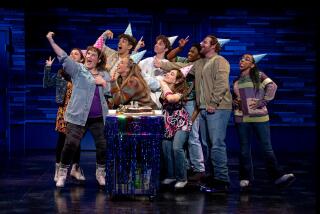Bright point in a dark ‘Lucia’
- Share via
There’s one great reason to see Los Angeles Opera’s presentation of “Lucia di Lammermoor”: Anna Netrebko in the title role. The young and beautiful Kirov Opera soprano, who once earned money scrubbing floors at the Maryinsky Theater in St. Petersburg, made her company debut Saturday at the Dorothy Chandler Pavilion with a stunningly detailed and involving portrayal of Donizetti’s tragic heroine.
Netrebko proved riveting from her first moments onstage, and she stayed credible throughout, whether recounting her vision of the ghost of a girl murdered by a jealous lover or, later, confronting her brother, Enrico, who wants her to marry the man he has chosen for her.
But it was in the famous mad scene, after Lucia loses her mind and kills that husband, that she most dazzled, both vocally and dramatically, working the action out to the last detail, yet appearing utterly spontaneous.
The difference between her acting and everyone else’s was so great, in fact, that it inevitably raised questions about Marthe Keller’s staging. Did Keller aim for that degree of contrast? Could she not get the same involvement from anyone else? Did she have no ideas about any of the other characters?
Keller’s old-fashioned treatment of the chorus was particularly poor. She had the singers stand around in massed groups, essentially uninvolved choristers in costume, facing front and singing out as if in an oratorio. No hint of individuals here.
If anything, the singers might execute synchronized, mechanical gestures, most risibly throwing up one stiffened arm and the other -- perhaps an echo of a Highland fling -- when saluting Arturo, who arrives to sign his marriage contract with Lucia.
This was Keller’s only identifiable nod to Scottish manners, having banished kilts and bagpipes when she set the opera in the pre-Raphaelite era, roughly 1848, to no discernible benefit. Most of her direction for the other principals resembled simplistic stand-and-sing opera.
As Edgardo, Lucia’s beloved, Jose Bros took a while to warm up vocally. But by the Wolf’s Crag Tower scene, his tenor was ringing brightly and heroically. Maybe he was saving himself for his final scene. He never did venture much credible acting, however, and there was little chemistry between him and Netrebko. Each seemed to do better apart than together.
Franco Vassallo’s Enrico was standard-issue brute baritone, with no hint of conflict about what he was forcing his sister to do out of responsibility or desperation for the survival of his clan. His later expressions of remorse made no credible impression. Vocally, he sounded nasal and constricted.
Vitalij Kowaljow started as a wooly voiced Raimondo, Lucia’s spiritual advisor, but his bass soon cleared and rang out resonantly. Kresimir Spicer made a bright-voiced Arturo. Margaret Thompson was an especially strong Alisa, Lucia’s friend. Javier Cortes, unfortunately, was easily overpowered as Normanno, the head of the Lammermoor guard.
None of the principal singers found opportunities to vocally embellish their lines, one of the attributes of bel canto style. Even in the mad scene, Netrebko didn’t approach, much less eclipse, Beverly Sills’ astonishing agility and creativity.
This shortcoming was all the more surprising because the master in the pit was Julius Rudel, who oversaw the glorious Sills era at the New York City Opera.
Rudel kept the action moving and tried -- not always successfully -- to make sure the orchestra didn’t overpower the small-voiced singers.
The production, from the Washington Opera, included large, stony towers and walls designed by James Noone. A scrim displayed a black-and-white stormy sky, and before the action began, sounds of sea gulls could be heard.
Inside the Lammermoor castle, the sight of towers of antlers, one above another, over the two fireplaces drew snickers from the audience, as did the little blast of leaves blowing in the door at Edgardo’s ruined Ravenswood castle. Rain fell noisily outside the windows during the marriage-contract signing scene but somehow stopped just in time for the famous Sextet to be heard without competition.
Jess Goldstein created the heavy, floor-length dark costumes, of which Lucia’s rich-toned wedding dress stood out. Alan Burrett lighted the sets moodily.
For all that, Netrebko was definitely the star of this show.
*
‘Lucia di Lammermoor’
Who: Los Angeles Opera
Where: Dorothy Chandler Pavilion, 135 N. Grand Ave., Los Angeles
When: Sunday, Dec. 4, 12 and 17 at 7:30 p.m.; Dec. 7, 14 and 20 at 2 p.m.
Price: $25-$170
Contact: (213) 972-8001
More to Read
The biggest entertainment stories
Get our big stories about Hollywood, film, television, music, arts, culture and more right in your inbox as soon as they publish.
You may occasionally receive promotional content from the Los Angeles Times.










